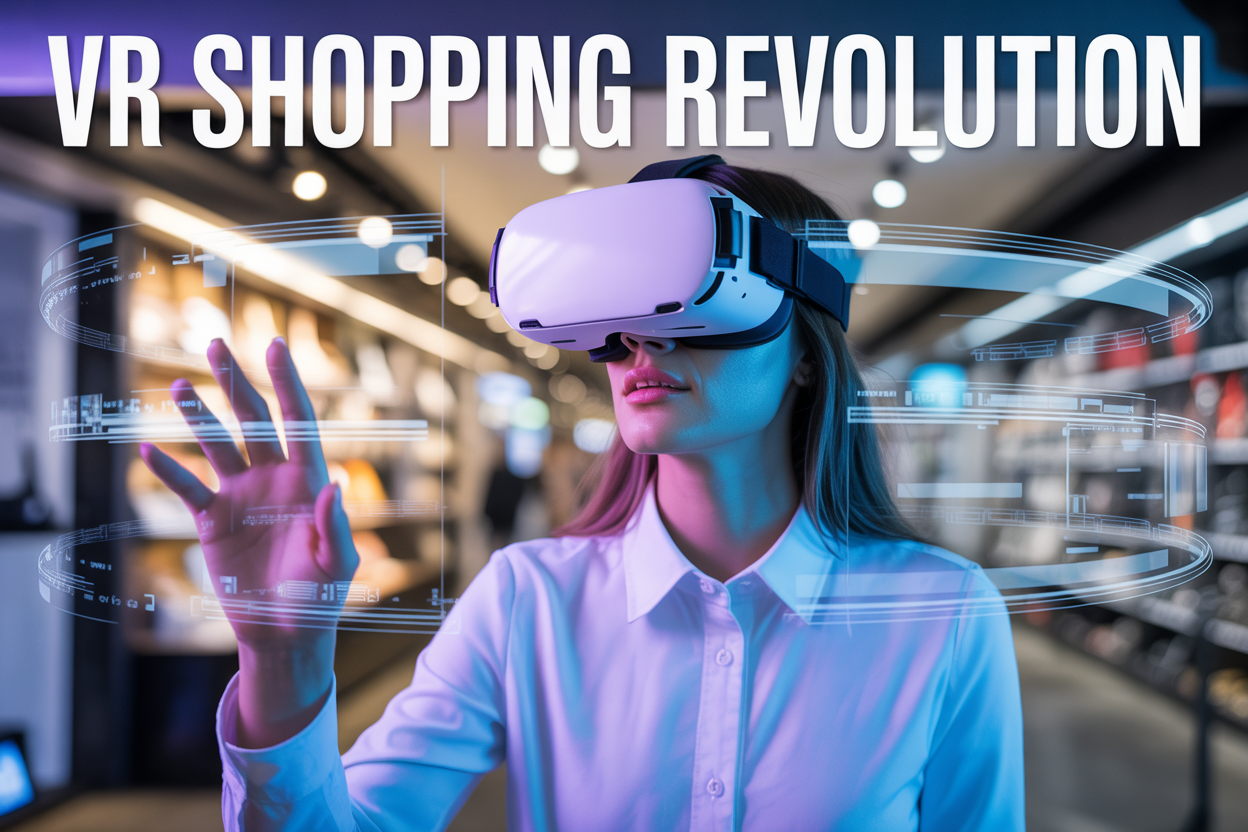
Shopping just got mind-blowing. Virtual reality transforms how we browse, try on, and buy products.
The latest VR technology makes shopping feel like stepping into the future. Retailers worldwide now use immersive virtual reality shopping experiences to engage customers in ways traditional online shopping never could. This breakthrough technology appeals to tech-savvy shoppers, forward-thinking retailers, and anyone tired of guessing if that couch will fit their living room or if those shoes really match their outfit.
We’ll explore how revolutionary VR retail technology creates incredibly realistic shopping environments where you can walk through virtual stores, examine products from every angle, and even see how furniture looks in your actual home before buying. You’ll discover the massive business benefits retailers gain from VR shopping implementation, including higher conversion rates, reduced returns, and deeper customer engagement that traditional e-commerce simply cannot match.
The future of retail is here, and it’s changing everything about how we shop.
Revolutionary VR Technology Transforms Retail Experience
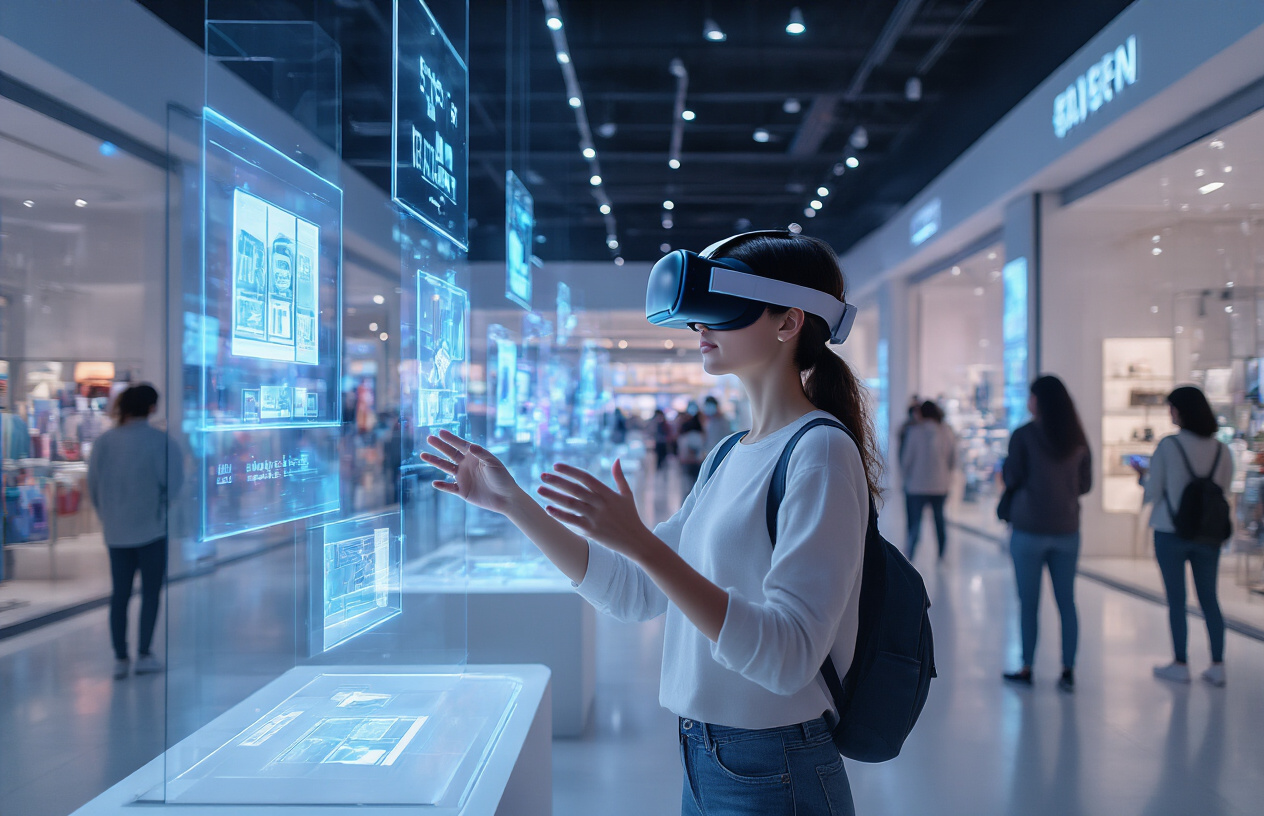
Immersive Virtual Shopping Environments Replace Traditional Browsing
The landscape of retail is experiencing a seismic shift as VR shopping technology creates unprecedented immersive experiences that completely reimagine how customers interact with products. Virtual reality retail environments transport shoppers into meticulously crafted digital spaces where they can navigate through virtual stores, examine merchandise from every angle, and experience products in ways that traditional e-commerce platforms simply cannot match.
These virtual shopping experiences eliminate the constraints of physical space, allowing retailers to create expansive showrooms that showcase entire product catalogs without the limitations of inventory storage or floor space. Customers can walk through virtual aisles, reach for items on digital shelves, and explore products with a level of detail that surpasses even in-person shopping experiences. The immersive retail technology enables brands to craft themed environments that align with their identity, creating memorable shopping journeys that strengthen brand connection.
Advanced Haptic Feedback Allows Customers to Feel Products Digitally
Revolutionary haptic technology integration represents a breakthrough in virtual reality shopping benefits, bridging the gap between digital and physical product interaction. This cutting-edge feature enables customers to experience tactile sensations through specialized VR controllers and wearable devices, allowing them to feel the texture of fabrics, the weight of objects, and even the resistance of materials.
The haptic feedback system translates digital product properties into physical sensations, enabling shoppers to assess product quality through touch. When examining a leather jacket, customers can feel the smoothness of the material, while testing electronics allows them to experience button responsiveness and build quality. This technology addresses one of the most significant barriers to online shopping – the inability to physically interact with products before purchase.
Retailers implementing this VR technology in retail report significantly reduced return rates, as customers make more informed purchasing decisions when they can virtually touch and manipulate products. The technology continues advancing, with newer systems providing increasingly sophisticated tactile feedback that closely mimics real-world interactions.
AI-Powered Personalization Creates Tailored Shopping Journeys
The integration of artificial intelligence with VR customer engagement creates highly personalized virtual shopping experiences that adapt to individual preferences, shopping history, and behavioral patterns. AI algorithms analyze customer data to curate virtual environments that showcase products most relevant to each shopper’s interests and needs.
These intelligent systems learn from customer interactions within the virtual space, noting which products receive the most attention, how long customers spend examining specific items, and their navigation patterns through the virtual store. This data enables real-time adjustments to the shopping environment, highlighting preferred brands, adjusting product recommendations, and even modifying the virtual store layout to optimize the customer journey.
The personalization extends beyond product recommendations to include customized virtual environments that match individual style preferences. Fashion-forward customers might find themselves in sleek, modern showrooms, while those preferring traditional aesthetics experience classic retail environments. This level of customization enhances customer satisfaction and increases conversion rates.
Real-Time Product Visualization in Customers’ Actual Spaces
Perhaps the most transformative aspect of modern VR shopping lies in augmented reality integration that allows customers to visualize products within their real-world environments. This feature enables shoppers to place furniture in their living rooms, test how artwork looks on their walls, or see how appliances fit in their kitchens before making purchase decisions.
The technology uses advanced spatial mapping and computer vision to accurately scale and position virtual products within customers’ actual spaces. This capability is particularly valuable for home furnishing, interior design, and large appliance purchases where spatial compatibility is crucial. Customers can walk around virtual furniture, examine how lighting affects colors and finishes, and ensure that dimensions work perfectly within their spaces.
This real-time visualization capability significantly reduces purchasing uncertainty and buyer’s remorse while increasing customer confidence in their decisions. The future of retail technology continues evolving as this immersive approach to product demonstration becomes increasingly sophisticated and accessible across various product categories.
Enhanced Customer Engagement Through Virtual Reality
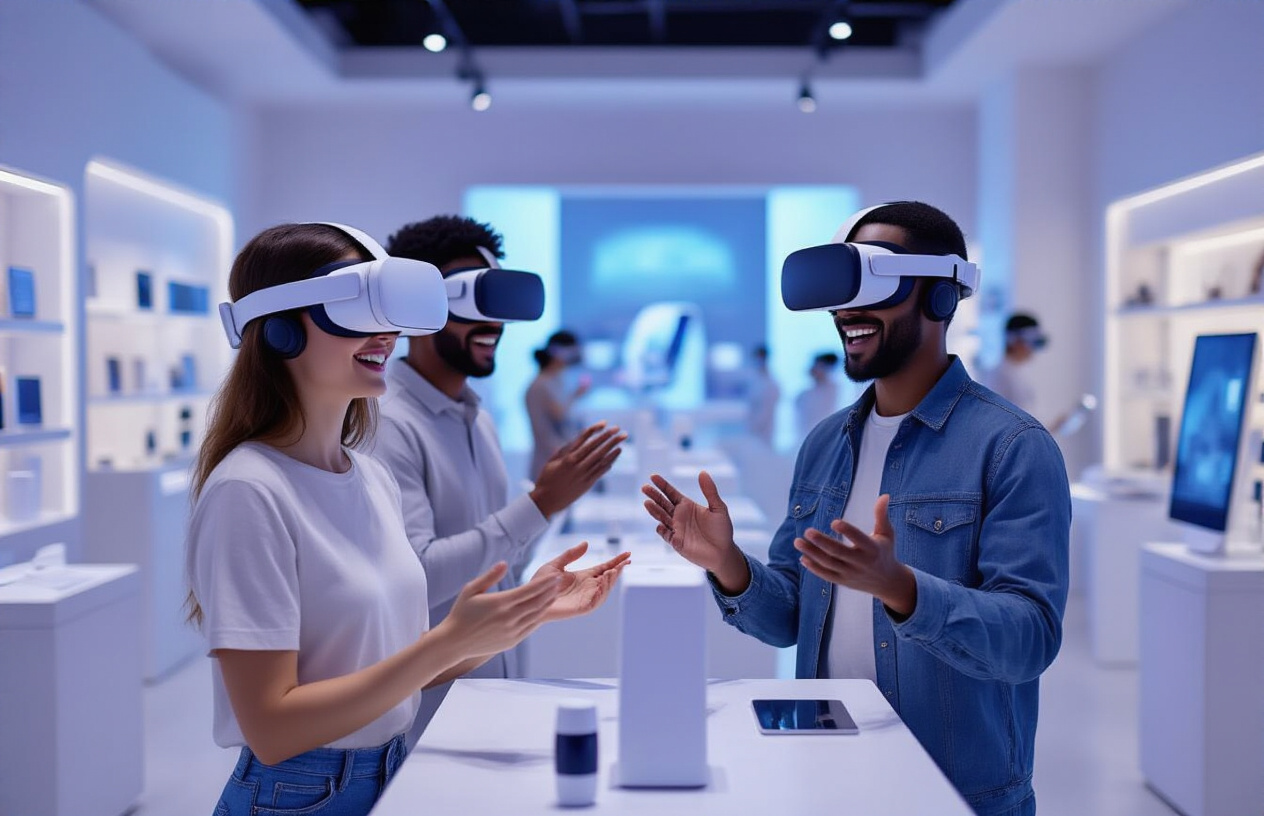
Interactive Product Demonstrations Increase Purchase Confidence
Now that we have covered how revolutionary VR technology transforms retail experience, let’s explore how enhanced customer engagement through virtual reality is reshaping the shopping landscape. Interactive product demonstrations in VR shopping environments create unprecedented levels of customer confidence by allowing shoppers to examine products in three-dimensional detail before making purchasing decisions. This immersive retail technology enables customers to rotate, zoom, and interact with virtual products as if they were physically present, eliminating the uncertainty that often accompanies online shopping.
Virtual reality retail experiences provide customers with the ability to visualize products in their own spaces through augmented overlays and spatial mapping. For electronics, customers can see how devices function, explore internal components, and understand technical specifications through guided virtual demonstrations. Fashion retailers leverage this technology to showcase fabric textures, color variations under different lighting conditions, and detailed craftsmanship that static images cannot convey effectively.
Virtual Try-On Capabilities Reduce Return Rates Significantly
Previously, online shoppers faced significant challenges when purchasing items without physical interaction, leading to high return rates and customer dissatisfaction. Virtual try-on capabilities in VR technology in retail address this fundamental issue by providing accurate sizing and fit visualization before purchase completion. These VR customer engagement tools utilize advanced body scanning technology and realistic physics simulations to show how clothing, accessories, and footwear will appear and fit on individual body types.
Virtual reality shopping benefits extend beyond apparel to include furniture placement, home décor visualization, and automotive customization options. Customers can virtually “try on” furniture in their actual living spaces, experiment with different color schemes, and assess scale compatibility without the traditional risks associated with large purchases. This enhanced shopping experience dramatically reduces return rates while simultaneously increasing customer satisfaction and brand loyalty.
Gamified Shopping Experiences Boost Customer Retention
With this in mind, let’s examine how gamification elements within virtual shopping experiences create compelling reasons for customers to return repeatedly. Gamified VR shopping transforms routine purchasing activities into engaging, interactive adventures that reward exploration and brand interaction. Customers earn points, unlock exclusive content, and participate in virtual treasure hunts while discovering products, creating emotional connections that extend far beyond transactional relationships.
These immersive retail technology implementations include virtual loyalty programs, achievement systems, and social sharing mechanisms that encourage repeat engagement. Customers can collect virtual badges for product discoveries, compete with friends in shopping challenges, and access exclusive VR-only merchandise or experiences. This approach transforms shopping from a task into entertainment, significantly increasing the time customers spend engaging with brands and their products.
Social VR Features Enable Collaborative Shopping with Friends
Future of retail technology embraces the social aspects of shopping through collaborative VR experiences that replicate and enhance traditional group shopping dynamics. Social VR features allow friends and family members to join virtual shopping sessions regardless of physical location, creating shared experiences that combine convenience with social interaction. These collaborative environments enable real-time communication, shared product examination, and group decision-making processes that mirror in-person shopping experiences.
Retail VR implementation includes virtual fitting rooms where multiple users can provide feedback, shared wishlists that update in real-time, and group discount opportunities that incentivize collective purchasing decisions. Social proof mechanisms within these virtual environments display friend recommendations, previous purchases from social networks, and real-time popularity indicators that influence purchasing behaviors. This social integration transforms VR shopping ROI by leveraging peer influence and creating viral marketing opportunities through shared virtual experiences and social media integration.
Business Benefits and ROI of VR Shopping Implementation
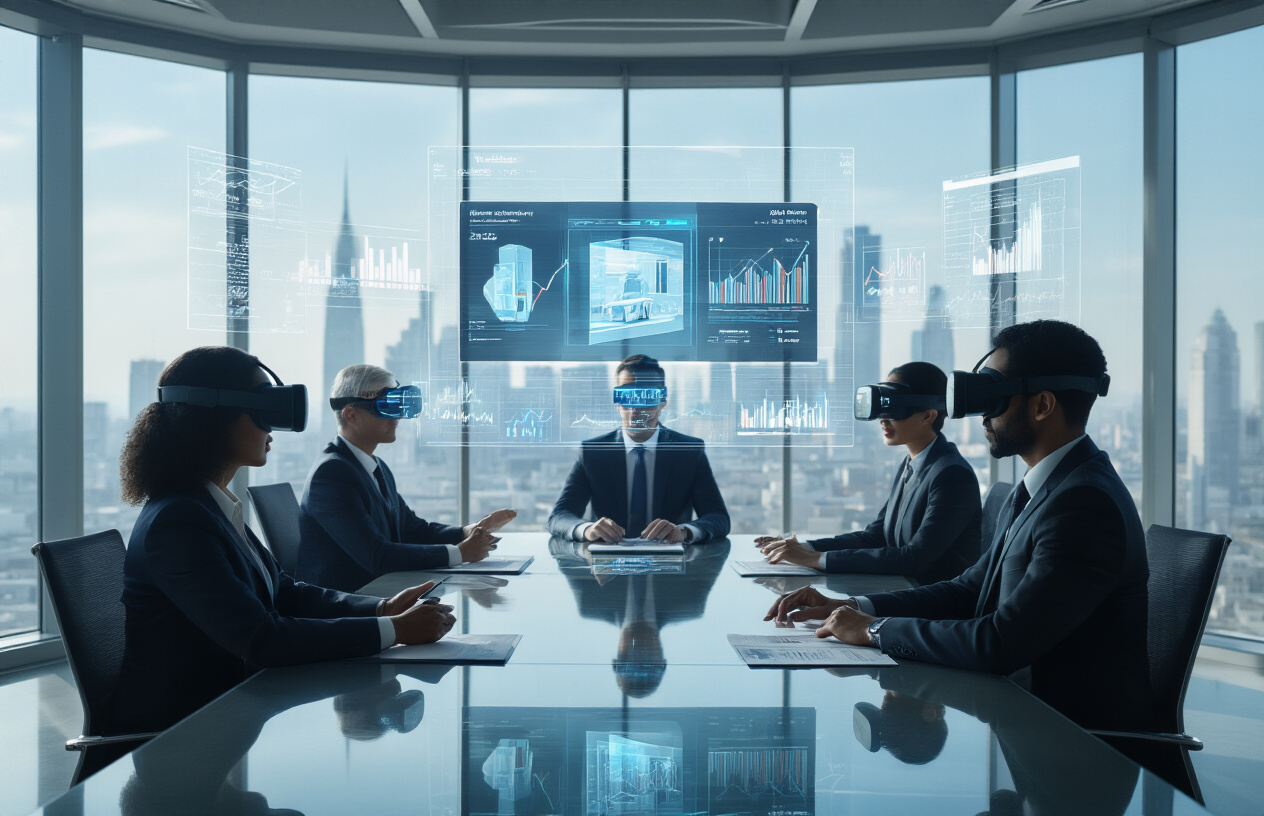
Reduced Physical Inventory Costs Through Virtual Showrooms
VR shopping implementation delivers substantial cost savings by dramatically reducing the need for extensive physical inventory storage. Traditional retail operations require significant investment in warehouse space, inventory management systems, and product handling logistics. Virtual showrooms enable retailers to showcase unlimited product catalogs without the associated overhead of physical storage facilities.
The virtual reality retail approach allows businesses to display products digitally while maintaining minimal physical stock levels. This just-in-time inventory model reduces carrying costs, eliminates excess inventory risks, and minimizes product obsolescence. Retailers can test market demand for new products through virtual displays before committing to large-scale physical inventory purchases.
Virtual showrooms also eliminate the costs associated with product damage, theft, and deterioration that plague traditional retail environments. The immersive retail technology enables customers to interact with products virtually, reducing the need for physical samples and demonstration units that typically require frequent replacement.
Expanded Global Reach Without Geographical Limitations
VR technology in retail breaks down geographical barriers, enabling businesses to serve customers worldwide without establishing physical store locations. This global accessibility transforms local retailers into international brands overnight, accessing markets previously unreachable due to logistical or financial constraints.
The virtual shopping experience eliminates shipping costs for product exploration and selection processes. Customers can virtually visit stores, examine products, and make informed purchasing decisions regardless of their physical location. This expansion capability particularly benefits specialty retailers with unique product offerings that appeal to niche global markets.
International market penetration through VR shopping requires minimal infrastructure investment compared to traditional expansion methods. Retailers avoid the substantial costs of international real estate, local staffing, and regulatory compliance associated with physical store establishment. The retail VR implementation provides immediate market access while maintaining centralized operations and inventory management.
Detailed Analytics and Customer Behavior Tracking Capabilities
VR customer engagement platforms generate unprecedented insights into consumer behavior patterns and preferences. Every virtual interaction creates valuable data points, including product engagement duration, navigation patterns, and decision-making processes. This granular analytics capability surpasses traditional retail tracking methods.
The immersive technology captures detailed customer journey mapping, revealing how consumers interact with products in virtual environments. Heat mapping analytics show which products attract attention, how long customers spend examining specific features, and which virtual store areas generate the highest engagement levels. This data enables retailers to optimize product placement, store layout, and inventory decisions.
Predictive analytics derived from VR shopping behavior help retailers anticipate demand patterns and personalize customer experiences. The system can identify purchasing triggers, preference indicators, and behavioral anomalies that inform targeted marketing strategies and inventory planning decisions.
Streamlined Operations with Automated Virtual Assistants
Virtual reality shopping benefits include sophisticated automation through AI-powered virtual assistants that handle customer service, product recommendations, and transaction processing. These digital agents provide 24/7 availability while reducing labor costs associated with traditional customer service operations.
The future of retail technology integrates natural language processing with VR environments, enabling virtual assistants to understand customer queries, provide detailed product information, and facilitate seamless purchasing processes. This automation reduces operational overhead while improving customer satisfaction through instant response capabilities.
VR shopping ROI improves through automated inventory management systems that track virtual product interactions and automatically trigger restocking procedures. The integration of virtual assistants with backend systems creates efficient operational workflows that minimize human intervention while maintaining high service quality standards.
Overcoming Traditional Shopping Limitations
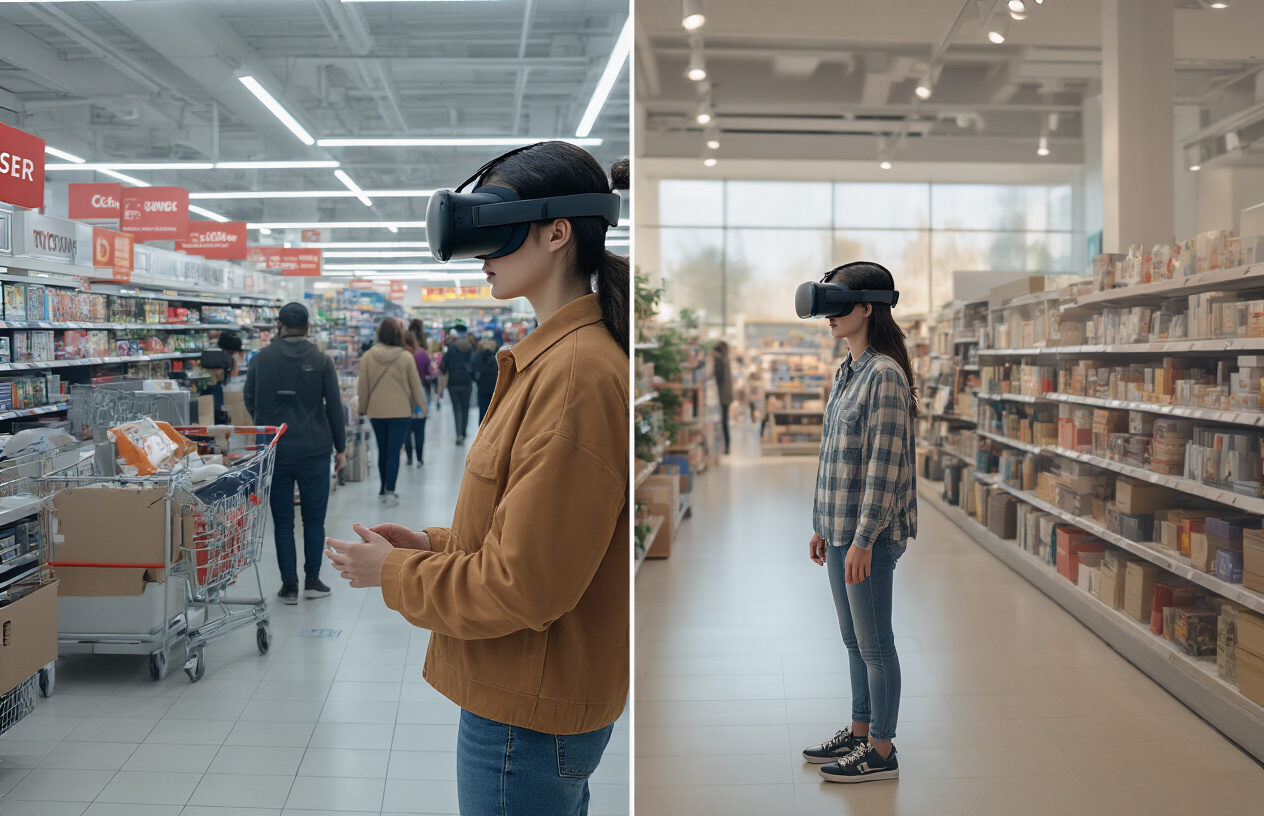
Elimination of size and space constraints in product displays
Traditional brick-and-mortar retailers face constant challenges with limited floor space and inventory display capacity. VR shopping technology revolutionizes this constraint by creating unlimited virtual showrooms where businesses can showcase their entire product range without physical space limitations. Retailers can now present thousands of items in immersive virtual environments, allowing customers to explore products in ways that would be impossible in physical stores.
Virtual reality retail environments enable businesses to create expansive digital showrooms that transcend the boundaries of traditional retail spaces. Customers can virtually walk through massive furniture stores, examine clothing collections in unlimited detail, or explore electronics displays that would require warehouse-sized facilities in the physical world. This transformation allows retailers to maximize their product exposure while minimizing overhead costs associated with large physical locations.
The technology also enables dynamic product placement and seasonal displays that can be instantly updated without the labor-intensive process of physical store rearrangements. Retailers can create themed virtual environments, seasonal showcases, or specialized product categories that adapt instantly to customer preferences and market trends.
24/7 accessibility regardless of physical store hours
VR technology in retail eliminates the traditional constraints of business hours, providing customers with round-the-clock access to virtual shopping experiences. This constant availability addresses one of the most significant limitations of conventional retail – time restrictions that often conflict with customer schedules.
Virtual shopping experiences allow customers to browse, examine, and purchase products at their convenience, whether it’s during lunch breaks, late evenings, or early mornings. This accessibility particularly benefits working professionals, parents with busy schedules, and international customers in different time zones who previously faced limitations accessing retail services during traditional business hours.
The immersive retail technology maintains full functionality regardless of the time of day, providing consistent customer service through AI-powered virtual assistants and automated support systems. Customers can receive detailed product information, compare items, and complete transactions without waiting for store opening hours or dealing with rushed shopping experiences during peak times.
Instant access to complete product catalogs and variations
One of the most compelling advantages of VR shopping is the immediate availability of comprehensive product inventories and variations. Traditional retail locations often struggle with limited stock displays, forcing customers to request specific sizes, colors, or models that may not be readily visible on the sales floor.
Virtual reality shopping benefits include instant access to complete product lines, allowing customers to visualize every available variation of a product simultaneously. Whether shopping for clothing in different colors and sizes, furniture in various finishes, or electronics with different specifications, customers can instantly switch between options without waiting for staff assistance or inventory checks.
This immediate accessibility extends to detailed product information, 360-degree views, and interactive demonstrations that would be impossible or impractical in physical retail environments. Customers can examine product features, compare specifications side-by-side, and access comprehensive reviews and ratings instantly, creating a more informed shopping experience.
Seamless integration with existing e-commerce platforms
Modern VR customer engagement solutions are designed to work harmoniously with established e-commerce systems, ensuring retailers can implement virtual reality shopping without disrupting existing operations. This integration capability allows businesses to maintain their current inventory management, payment processing, and customer relationship management systems while adding immersive virtual shopping capabilities.
The retail VR implementation process connects virtual showrooms directly to existing product databases, ensuring real-time inventory accuracy and pricing consistency across all sales channels. Customers can seamlessly transition from virtual reality exploration to traditional online checkout processes, maintaining familiar payment methods and shipping preferences.
This technological integration also enables comprehensive analytics and customer behavior tracking across both virtual and traditional shopping channels. Retailers can gather valuable insights about customer preferences, product interaction patterns, and conversion rates, allowing them to optimize both their virtual reality shopping experiences and overall retail strategies for maximum effectiveness and return on investment.
Future-Proofing Retail with VR Technology
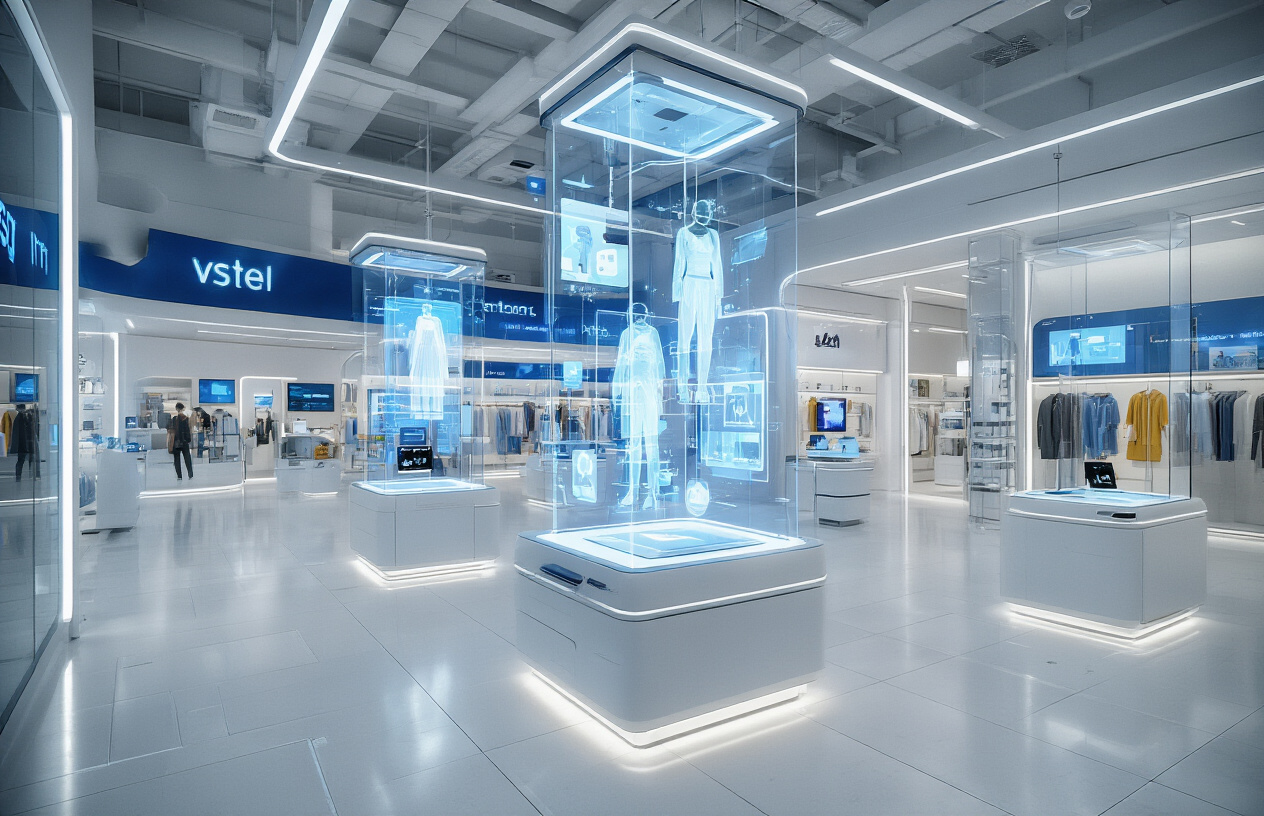
Integration with emerging technologies like AR and AI
The convergence of VR shopping with augmented reality (AR) and artificial intelligence represents the next frontier in retail innovation. This technological synergy creates unprecedented opportunities for retailers to deliver personalized, intelligent shopping experiences that adapt to individual customer preferences in real-time.
Smart VR systems powered by AI algorithms can analyze customer behavior patterns, purchase history, and browsing preferences to create highly customized virtual shopping environments. These intelligent systems learn from each interaction, continuously refining product recommendations and store layouts to maximize engagement and conversion rates. When combined with AR capabilities, customers can seamlessly transition between virtual product exploration and real-world visualization, creating a hybrid shopping experience that bridges the gap between digital and physical retail.
Machine learning integration within VR shopping platforms enables predictive analytics that anticipate customer needs before they’re explicitly expressed. This proactive approach to customer service revolutionizes the traditional reactive model, positioning retailers ahead of consumer demands and creating competitive advantages in the rapidly evolving digital marketplace.
Sustainable shopping solutions reducing environmental impact
VR technology in retail offers compelling solutions to environmental challenges facing modern commerce. Virtual showrooms eliminate the need for extensive physical inventory displays, significantly reducing the carbon footprint associated with manufacturing, shipping, and storing demonstration products across multiple locations.
Digital product experiences reduce packaging waste by allowing customers to fully evaluate products before purchase, leading to more informed buying decisions and fewer returns. This reduction in reverse logistics translates to decreased transportation emissions and packaging materials consumption.
Virtual shopping experiences also minimize the need for customers to travel to physical locations, particularly for initial product research and comparison shopping. By enabling comprehensive product evaluation from home, VR shopping contributes to reduced transportation-related emissions while maintaining high-quality customer experiences.
The implementation of VR shopping solutions supports circular economy principles by enabling virtual product testing and customization without physical material waste. Retailers can offer unlimited product variations and configurations in virtual environments without the environmental costs associated with physical prototyping and sampling.
Preparation for next-generation consumer expectations
Today’s digital-native consumers expect seamless, personalized, and instantly accessible shopping experiences that traditional retail models struggle to deliver. VR shopping technology positions retailers to meet and exceed these evolving expectations by providing immersive experiences that surpass conventional online and in-store shopping limitations.
Next-generation consumers prioritize convenience, personalization, and engagement over traditional shopping paradigms. VR technology addresses these priorities by offering 24/7 accessibility to fully immersive product experiences, personalized virtual environments, and interactive features that transform shopping from a transactional activity into an entertainment experience.
The preparation for future consumer expectations includes developing omnichannel VR shopping experiences that integrate across multiple touchpoints and devices. This comprehensive approach ensures consistent customer experiences whether accessing virtual stores through VR headsets, mobile devices, or desktop computers.
Competitive advantage in evolving digital marketplace
Early adoption of VR technology in retail creates significant competitive advantages by establishing market leadership positions before widespread industry adoption. Retailers implementing comprehensive VR shopping solutions differentiate themselves from competitors still relying on traditional e-commerce platforms and static product presentations.
The competitive advantages extend beyond customer acquisition to include enhanced brand perception, increased customer loyalty, and premium positioning opportunities. Brands offering cutting-edge VR shopping experiences position themselves as innovation leaders, attracting tech-savvy consumers and generating positive brand associations with forward-thinking retail approaches.
VR shopping implementation also provides valuable data insights unavailable through traditional retail channels. These behavioral analytics offer deep understanding of customer preferences, product interaction patterns, and virtual space navigation behaviors, enabling data-driven optimization strategies that maintain competitive advantages over time.
The scalability of VR shopping platforms ensures that initial investments in VR technology continue delivering returns as the technology matures and adoption rates increase across target demographics.

VR technology is fundamentally transforming the retail landscape, offering unprecedented opportunities for businesses to enhance customer engagement and overcome traditional shopping limitations. From immersive product experiences to reduced return rates and increased customer satisfaction, the business benefits and ROI of VR shopping implementations are becoming increasingly clear. Retailers who embrace this technology now position themselves at the forefront of a revolutionary shift in how consumers interact with brands and make purchasing decisions.
The future of retail lies in creating seamless, engaging virtual experiences that bridge the gap between online convenience and in-store interaction. As VR technology continues to evolve and become more accessible, businesses that invest in these solutions today will build stronger customer relationships, drive higher conversion rates, and establish themselves as industry leaders. The question is no longer whether VR will reshape retail, but how quickly forward-thinking businesses will adopt this game-changing technology to stay competitive in an increasingly digital marketplace.

